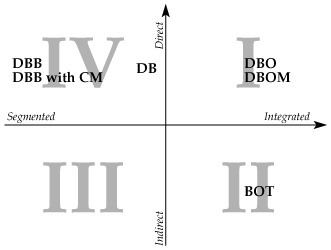 | ||
A project delivery method is a system used by an agency or owner for organizing and financing design, construction, operations, and maintenance services for a structure or facility by entering into legal agreements with one or more entities or parties.
Contents
Types
Common project delivery methods include:
Trends in delivery method prevalence
Though DBB is now used for most private projects and the majority of public projects, it has not historically been the predominant delivery method of choice. The master builders of centuries past acted both as designers and constructors for both public and private clients. In the United States, Zane's Post Road in Ohio and the IRT in New York City were both originally developed under more integrated delivery methods, as were most infrastructure projects until 1933. Integrated Project Delivery offers a new delivery method to remove considerable waste from the construction process while improving quality and a return to more collaborative methods from the past.
Conceptual differences between delivery methods
There are two key variables which account for the bulk of the variation between delivery methods:
When the various service providers are segmented, the owner has the most amount of control, but this control is costly and doesn't give each provider an incentive to optimize its contribution for the next service. When there is tight integration amongst providers, each step of the delivery is undertaken with future activities in mind, resulting in cost savings, but limiting the owner's influence throughout the project.
The owner's direct financing of a project simply means that the owner directly pays the providers for their services. In the case of a facility with a consistent revenue stream, indirect financing becomes possible: rather than be paid by the owner, the providers are paid with the revenue collected from the facility's operation.
Indirect financing risks being mistaken for privatization. Though the providers do have a concession to operate and collect revenue from a facility that they built and financed, the structure itself remains the property of the owner (usually a government agency in the case of public infrastructure).
